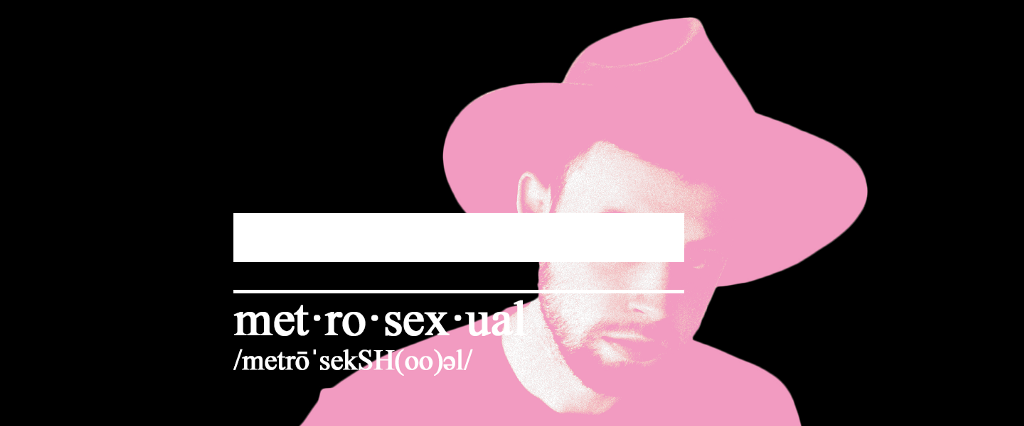It’s been nearly a quarter century since author and journalist Mark Simpsoncoined the term “metrosexual.” Writing in The Independent back in 1994, he described an emerging subculture of men who had been “kept underground for too long.” He described them — i.e., metrosexuals — as having “a perfect complexion and precisely gelled hair, and inspecting a display of costly aftershaves. This exhibition shows that male vanity’s finally coming out of the closet.”
“Unlike homosexuality,” Simpson continued, “metrosexuality is determined exclusively by artifice. But when I asked friends to delineate that artifice by describing ‘metrosexual fashion,’ there was no consensus (rings? v-neck tees? scarves?). There are also no obvious metrosexual products, and certainly no defining brands — like Sperry Top-Siders are to preppies or Herschel is to hipsters.
“Metrosexual man, the single young man with a high disposable income, living or working in the city (because that’s where all the best shops are), is perhaps the most promising consumer market of the decade. In the 1980s, he was only to be found inside fashion magazines such as GQ, in television advertisements for Levi’s jeans or in gay bars. In the 1990s, he’s everywhere and he’s going shopping.”
He eventually made his way to TV, too. Spreading the gospel of the power and popularity of metrosexuals was essentially the premise of the 2003 Bravo series Queer Eye for the Straight Guy. On it, straight, inept men with no fashion sense living in squalid bachelor pads are given lifestyle makeovers by five “Queer” men (who were dubbed the Fab Five). By the end of each episode then, they fully embody “metrosexuality” and its five main pillars as the show’s creators saw them — style, interior decoration, grooming, culture and food. It was, as the opening credits promised, where Gay Street met Straight Street. (The show was a giant hit, single-handedly transforming Bravo from the James Lipton/Inside the Actors Studio station to the Andy Cohen/Real Housewives juggernaut it is today.)
But then, like with the original series, the word, more or less, faded from popular imagination. Still, in an era where everything that’s old is new again — or at the very least, a bankable entertainment asset — Netflix recently dusted off the series, in which the emphasis is more on shaking men free of their toxic masculinity than ensuring that their grooming habits reflect those of David Beckham.
And so, not surprisingly — to Simpson most of all — the term “metrosexual” is nowhere to be found.
“There was a moral panic around [the term],” explains Simpson when I caught up with him for a quick chat earlier this week, adding that this moral panic eventually created a “phobia” over its use. “The uptake of ‘gay’ beauty concerns, along with the ‘feminine’ desire to be desirable, was something well underway in men by the noughties — without an intervention from the Fab Five. But once the sexual ambiguity of it finally sunk in — despite the blandishments of marketers — it helped get Queer Eye, which basically sold itself as the metrosexual makeover show, cancelled. ‘Metrosexual’ [the word] was apparently banned in the U.S. in the late noughties — except as another, more acceptable way to say ‘faggot.’”
“But even in the U.S., metrosexuality [as a concept] continued to triumph — men continued to appropriate products, practices and pleasures previously ring-fenced for ‘women and gays.’ So long as it had ‘MAN’ strapped to the front, like a phallic pacifier. And so long as you didn’t talk about what any of it might mean,” he clarifies.
When I ask him why this is still the case even with the advances in the way society and popular culture talks about the fluidity of sexual identity today, he says, “Today masculinity has largely been madeover in the U.S. — certainly in metropolitan areas and for young men — at least aesthetically. The previously pathologized ‘passive’ male desire to be desired, which was always the self-regarding heart of metrosexuality, has become thoroughly mainstream. It’s now the new normal. How could it not in a hyper-visual, social media, selfie culture?”
It’s why Simpson believes other terms like “spornosexual” are more relevant today. In 2014, writing in The Daily Telegraph, he claimed that ‘metrosexuality was dead’ and that spornosexuality, a “hyperised form” of metrosexuality, had taken its place. “Spornosexuality doesn’t ‘replace’ metrosexuality. It’s just a more intense, body-centred, ‘hardcore’ manifestation of it,” Simpson tells me. “It deliberately makes it more visible and noticeable. The male desire to be desired made pumped, primed, shredded and shareable flesh. Instead of fetishizing designer shirts, the spornosexual fashions his own body into a hot commodity — for online likes and shares.”
To Simpson, the premise of men’s sexuality being linked to consumerism and commodification hasn’t necessarily disappeared, it’s just that the means of public validation have expanded in the social media age. “The spornosexual, who often looks like a gay porn star, especially if he’s straight, also makes alarmingly clear what I argued about metrosexuality from the beginning — that the male desire to be desired meant men admiring and possibly desiring other men, too.”
“If anything, it was because [metrosexuality] allowed men a freedom they never had before that it became so mainstream,” says Simpson, who still regularly writes about men’s issues on his blog and in various international publications. “It basically went against every conception of what a man should be throughout the 20th century.
“In a sense then, metrosexuals are everywhere now. And because of that, they’re essentially nowhere.”

